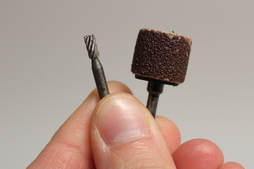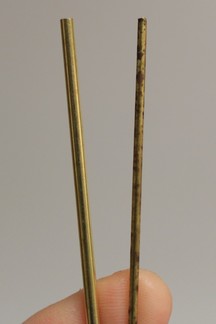Without further ado, let me hand the screen over to Kim for her pre-NaMoPaoMo post!
Let the madness begin!!
& now for a word from my friend Carole on her chosen victim!
He is second hand, his mold having been released in 2002! (Good Lord, was that really 16 years ago?!?) He had a basic prep job, a coat of white primer, & a layer of airbrushed acrylic. He had also suffered a cracked tail which had been repaired. His great price more than made up for any of this though.
My! I never realized how BIG this sculpt is!! He's quite a hunk!
Reinforcing Breaks With Wire Or Brass Rod

*A Dremel
*A high speed spiral flute cutter bit (I had to look that up! I have no idea what size it is, I've had it forever.) ...Or whatever size & shape bit will work for your project
*A 1/2" sanding drum ...or files & some elbow grease

*Wire cutters & two pairs of pliers in a size hefty enough to cut & bend whatever gauge you are using
*Wire or brass rod in a gauge suitable for your brake (I used brass rod from the hardware store, in 2.38 mm & 1.57mm.)
*Locktite super glue gel control
*Baking soda
*Epoxy, I used Aves Fixit, which is a very dense & sturdy epoxy
*Sand paper, my preferred grit being 220
*Any sculpting tools needed to resculpt lost details
Regardless of where the break is, the approach is pretty much standard:
Cut your wire & test it for a snug fit. I am using the bigger 3/32 (2.38mm) rod here.
Once all the brass rod was laid & ready to go, I mixed some Aves Fixit epoxy & pushed it into any crevices remaining, then resculpted the lost details. I chose Fixit since it is a very dense, hard epoxy once cured. I often use A + B epoxy which is even harder, for the more breakable areas like this. But it is more difficult to work with. Since I needed to sculpt hair here, I opted for the easier-to-use Fixit.
Stay tuned through the end of this month & all of February for many more reports on & tutorials for NaMoPaiMo!
Cheers all!
 RSS Feed
RSS Feed
